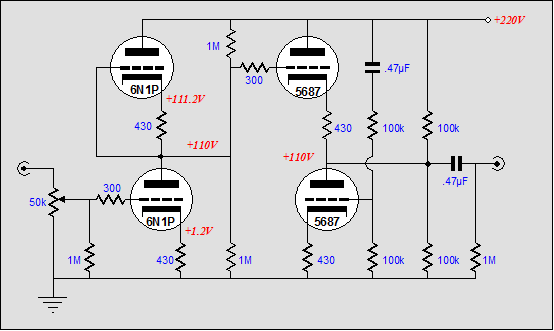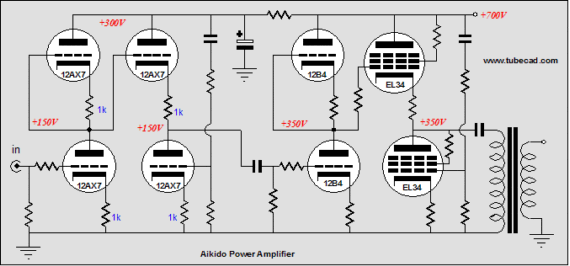16 January 2005

Subject: Aikido vs the rest
First, my thanks for the blogs. I like the way you compare many circuits with others. Your SRRP deconstructed article was rosetta stone for understanding the SRPP circuit. But I am more of a hands on guy than a thinker, so I have to solder to learn. I have made a SRPP, a Gomes , a XPP and an Aikido amplifier. Each amplifier is point to point wired and is on its own small (5 by 5 by 1) bud box and each uses the same type and value coupling capacitor (.22mmf) and each uses the same separate power supply (315 volts) through an umbilical cord and a DIN four pin connecter. All of the amplifiers are set up to use 6SN7’s.
Since I only made one of each, I can only test in mono. I used the same 6SN7(s) in each setup. After at least 30 hrs of listening, I have come to prejudices (conclusions are people with more test equipment than me) that I thought you and other readers of the Tube CAD Journal would like to know about.
The SRPP sounds a bit confused or cluttered (this used to be my favorite topology--no longer). The Gomes amplifier sounds a tad nervous, but good nervous, kind of exciting. The XPP amplifier sounds like a good 300B amplifier, kind of sweetly mellow, great on vocals. The Aikido amplifier sounds…well it just doesn’t sound like any flavor. I can use all the usual audio complementing adjectives, but really I think is just very clean sounding. It still sounds like a 6SN7, but very very clean. At first I thought it must be its great PSRR, but the power supply is very clean to start with (many big chokes, many capacitors, a voltage dropping resistor and dual 5AR4 rectifiers--it used to be part of a 50W monobloc amplifier I built).
Since all the triodes are the same and since the cathode resistor values are the same and since each triode splits the B+ voltage and draws the same current, does the distortion cancel out somehow? I don’t have the brain to figure it out, but my ears tell me that I like it best. (my wife also likes it best and she has much better ears than I do.)
I guess I just used up my one question per email, but here’s a suggestion instead of another question: explain in a future blog how to use the Aikido amplifier as a power output stage.
Cheers
Marc C
Australia
Subject: Tube Aikido Amp
I thought I would give you a little feedback re the Aikido preamp. After two days of listening (two long days of concentrated listening) I have to say the Aikido is not exactly what I expected and not quite like you described it. To start at the beginning, I was feeling the building urge. I have built two projects totally from scratch, including chassis. One is an SET amp (6DN7 into 572-10) and the other is the Ultrpath preamp with a 7193 replacing the 6SN7. Prior to that I modified commercial products for many years. I was first attracted to the Aikido because of the opportunity to hear and compare some of the NOS tubes I have been collecting on Ebay and in used electronic stores. (WW11 era 6Sn7, 6SL7, 6BX7, 6BL7, 5687, etc). There is something just a little sick about someone buying all these dusty old tubes with no equipment to use them in. With enough sockets I could even use some of my singles like 12B4A and 12A4. I had this big old ugly unused chassis I had been carrying around for 5 years looking for the right project. I decided to skip the breadboard stage and go directly to the permanent chassis. After all it is a proven design, right? You said you and at least two readers built it and no problems were mentioned. 8>) I wound up with 4 sockets per channel, 2 minature 9 pin and two octal. My ultimate goal was to eventually make it into an 8 tube phono pre. I knew that it was unlikely to match my fully trick Ultrapath as a line amp.
My prejudice is for good but simple circuitry and massively overbuilt power supplies. I decided to use the Ultrapath outboard raw power supply for the Aikido (Schotky full wave bridge into tuned quasi choke input LCRCLC and then two more chokes, one per channel. Don't laugh, I have two more chokes in the DC filament supply. Good thing I trained as a power lifter, because all the B+ caps are oil cans. Big and heavy!
Long story made short. I think I like it better than my Ultrapath. I am utterly amazed. Not much I can add to what the others said except I think they may have understated the quality of the design. I'm currently listening to 6SN7 into 6BX7. I haven't even wired it up for other than octals yet. Which leads me back to your low key description of this pre that almost caused me to pass it by. I hope you don't mind if I say a few nice things on the net and hopefully send another reader or two to your site.
Thank You, thank you
Bruce A
Tempe Arizona
Bruce has published a review of the Aikido amplifier he built at audioasylum.com. So far no bad reviews for the Aikido topology, only good reviews. (Actually, prior to the circuit having been built, it was panned at some DIY website. If only I held such
extrasensory
powers; why, I might even be able to adjust the cartridge tracking at a distance.) Even at the CES show, I met one TCJ reader who has probably the most expensive system I have ever heard of —my wallet aches from thinking about it. He too has built and tested the Aikido circuit and he is quite impressed with the results.
So what does the praise mean? As little or as much as wish to make of it. We don't know all the hundreds of variables: the purity of the wall voltage, the power supplies used, the signal source material, the interconnects, the parts quality, the volume controls, the power amplifiers, the speaker cable, the loudspeakers, the room acoustics, the mood the listeners were in, the wine they drank or didn’t drink… We just do not know. But the fact that all the reviews were positive moves me to further testing. I own a few beautiful, new old stock, empty MFA Magus preamp shells and remote power supply case. One of which, I plan on soon filling with an Aikido line stage.
In general, I don't pushing one topology over all the others, as each has its uses. I generally viewed as being anti-SRPP, but I just designed an SRPP circuit for my own use. There are no good or bad circuits, only good and bad uses for circuits. Nonetheless, I think Bruce is right on regarding this circuit: it is a particularly good one and it deserves a wider use. (Worldwide, my guess is that maybe twenty tube fanciers are using this circuit today, give or take ten.)
As for Marc’s question concerning some magical distortion cancellation function, I would not be surprised, as the two stages work anti-current-phase, so one stage’s even harmonic distortion could be canceled by the second stage’s even harmonic distortion. (However, in SPICE, all the harmonics above 2nd are way down.)
As for Marc’s stealth question, Could this circuit be used as a power output stage? It could, but it would entail addressing a few issues. First, the second stage operates in pure SE resistive-loaded class-A, so its maximum theoretical efficiency is only 25%, which in reality means 10%. In other words, it would take at least 100 watts of amplifier dissipation to produce 10 watts of power at the output.
Second, the top cathode follower triode’s cathode moves with the output signal, so a floating heater supply for it and the top driver tube should be used, which means that four tube envelopes will be needed per channel.
Third, the gain of the Aikido amplifier is roughly equal to half of the mu of the triode used in the first stage. This means that an additional gain stage will be needed, as even a 12AX7 will only give a gain of 50, which in turn is divided by the output transformer’s winding ratio.
Still, there is no reason that two Aikido amplifiers could not be cascaded; the first as a high-gain stage, the second as a power output stage. Below is one such amplifier.
 Click to see larger image Click to see larger image
The first Aikido amplifier uses 12AX7s to create a voltage gain of 50 and it uses its own filtered B+ connection. The second Aikido amplifier uses 12B4s and triode-connected EL34s to drive the capacitor-coupled output transformer and it uses its own root B+ power supply connection. (Before anyone writes to ask, yes, other output tubes can be used. Just remember to reference the heater power supplies to the output, which might be difficult with a directly-heated tube, such as the 2A3 or 300B.) The weak link is the 12B4, as its mu (about 7) is so low. A better choice might be to use half a 5687 for top and bottom positions. (Remember the heater concerns.)
If a tube headphone amplifier is your goal, then a single Aikido amplifier could suffice. I would look into using a 6N1P working into a 6H30 (6N30). No output transformer would be necessary with Sennheiser headphones, but it would be needed when driving Grados.
Building a phono preamp based on the Aikido circuit is a promising path to follow, as low noise is so important in this application. A passive equalization network could easily be nestled in between two Aikido gain stages. The equalization network holds a –20dB insertion loss at 1kHz, which means that the total gain for both gain stages must equal +60dB for a +40dB total preamp gain. For example, an all 12AX7 preamp would realize a final gain of +48dB, as each gain stage would yield 50x (+34dB), which added together equals +68dB, which in turn equals +48dB after the –20dB is subtracted. The only problem is that I would prefer not to use 12AX7s (5751s might make a good choice, as many come with an internal microphonic-eliminating stress band; look carefully inside, you’l see it in many of them; it works by preventing the mica wafers from rattling).
Using three Aikido amplifiers per channel would allow a much larger tube selection, but the total tube count would go up by four (assuming dual-triode envelopes).
More to come.
|
|
|
|
Kit User Guide PDFs
Click image to download











Only $12.95
to keep track of
your
tube and part collection
TCJ My-Stock DB
TCJ My-Stock DB helps you know just what you have, what it looks like, where it is, what it will be used for, and what it's worth. TCJ My-Stock DB helps you to keep track of your heap of electronic parts. More details.
List all of your parts in one DB.
Add part Images.
One-click web searches for information.
Vertical and horizontal grids.*
Create reports as PDFs.*
Graphs added 2D/3D: pie & bar.*
More powerful DB search.
Help system added.
Editable drop-down lists for location, projects, brands, styles, vendors and more.
*User definable
|

















